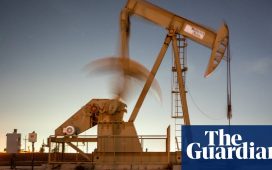The UK’s annual inflation rate fell sharply to 6.8% in July, down from 7.9% in June, as the drop in energy prices over the past year led to the smallest increase in the cost of living since February 2022.
Financial markets had been braced for a marked easing in upward price pressure last month, and the figure announced by the Office for National Statistics (ONS) was in line with their prediction.
Despite the large fall in the consumer prices index (CPI), the government’s preferred measure of inflation, analysts warned the outlook was not improving rapidly enough to prevent further interest rate increases from the Bank of England.
The drop in CPI means that for the first time since autumn 2021 prices are increasing less rapidly than wages, which rose by 8.2% a year in the three months to June, adding to pressure on Bank policymakers to increase rates for a 15th time since December 2021 when they meet next month.
The ONS said the main reason behind July’s fall was that the big jump in gas and electricity bills in the same month last year had not been repeated, although there was a decline in annual food inflation last month to below 15%.
Matthew Corder, the ONS deputy director of prices, said: “Inflation slowed markedly for the second consecutive month, driven by falls in the price of gas and electricity as the reduction in the energy price cap came into effect.
“Although remaining high, food price inflation has also eased again, particularly for milk, bread and cereal.”
There was less encouraging news for core inflation, which strips out volatile items such as fuel and food. The ONS said this remained unchanged at 6.9% last month. Service sector inflation, closely watched by Threadneedle Street as an indicator of domestically generated price pressure picked up from 7.2% to 7.4%.
Ruth Gregory, a UK analyst at Capital Economics, said the increase in service sector inflation coupled with strong wage growth meant the Bank was likely to press ahead with another 0.25 percentage point rise in interest rates from 5.25% to 5.50% next month.
“There will be one more labour market and one more inflation release before the Bank of England’s September policy meeting. But with wage growth and services inflation both stronger than the Bank had expected, it seems clear that the Bank has more work to do,” she said.
July’s decline in CPI gives Rishi Sunak hope that he could hit the target he set in January to halve inflation, from its then level of 10.7%, by the end of 2023. The prime minister said the fall showed “the plan is working”.
The chancellor, Jeremy Hunt, said: “The decisive action we’ve taken to tackle inflation is working, and the rate now stands at its lowest level since February last year.
“But while price rises are slowing, we’re not at the finish line. We must stick to our plan to halve inflation this year and get it back to the 2% target as soon as possible.”
after newsletter promotion
His Labour counterpart, Rachel Reeves, said that despite July’s fall, “inflation in Britain remains high, and higher than many other major economies”. The shadow chancellor added: “After 13 years of economic chaos and incompetence under the Conservatives, working people are worse off – with higher energy bills and prices in the shops.”
George Dibb, the head of the Institute for Public Policy Research thinktank’s Centre for Economic Justice, said: “It’s good news that headline inflation is lower, especially with energy bills coming down, but there is a very real risk that a recession may soon overtake price rises as the main economic concern. Other countries have brought inflation under control quicker than in the UK, with more support for households and workers avoiding unnecessary pain.”
Food prices rose by 14.9% in the year to July, down from 17.3% in the year to June. Clothing and footwear prices fell by more last month than in July 2022 as the poor weather led to more aggressive price cutting by retailers looking to sell summer stock.
Separate ONS figures for producer prices – which provide an early indication of inflationary pressure in the pipeline – fell last month. Industry’s fuel and raw material costs fell by 3.3% year on year, while the cost of goods leaving factory gates dropped by 0.8%.
Two years ago, inflation measured by the consumer prices index stood at 2% – in line with the government’s target – but it rose steadily in the months that followed and hit 6.2% in February 2022.
Russia’s invasion of Ukraine in that month gave an added boost to inflationary pressure by pushing up global oil and gas prices, and inflation peaked at 11.1% in October before falling back.
Despite its sharp fall last month, the UK’s inflation rate remained higher than that of the US (3.2%) and the eurozone (5.3%) in July.







